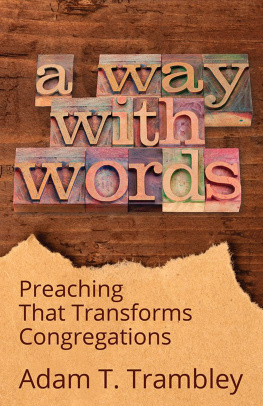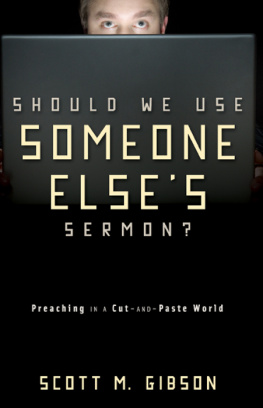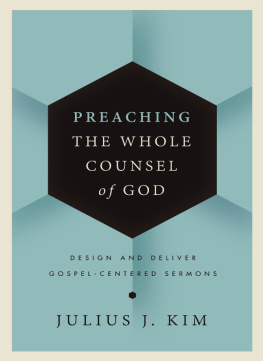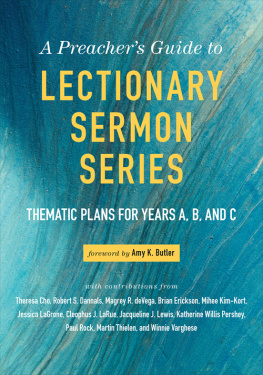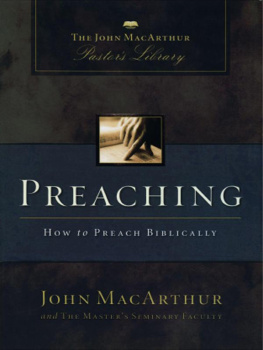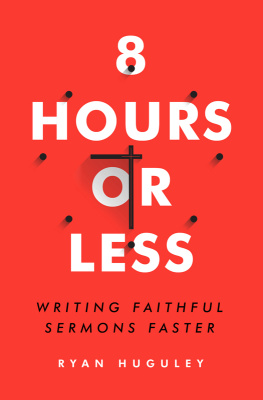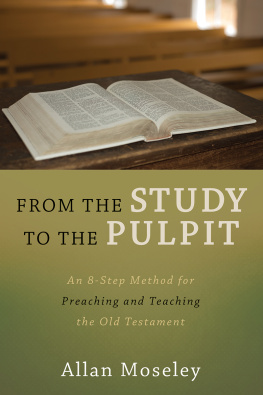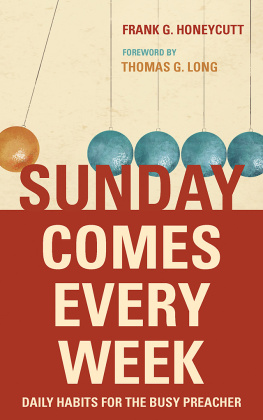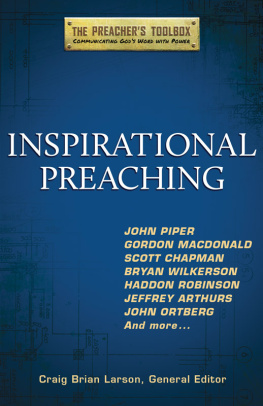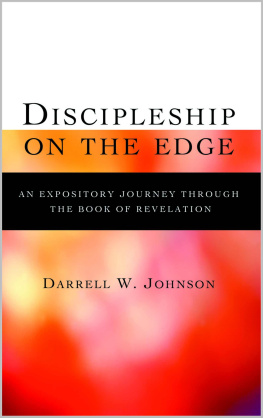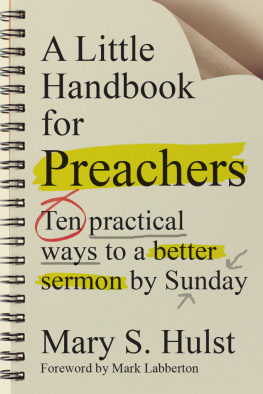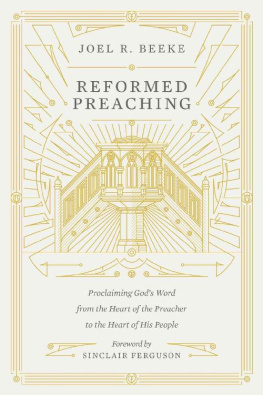A Way
with
Words
A Way
with
Words
Preaching
That Transforms
Congregations
Adam T. Trambley

Copyright 2020 by Adam T. Trambley
All rights reserved. No part of this book may be reproduced, stored in a retrieval system, or transmitted in any form or by any means, electronic or mechanical, including photocopying, recording, or otherwise, without the written permission of the publisher.
Unless otherwise noted, the Scripture quotations are from New Revised Standard Version Bible, copyright 1989 National Council of the Churches of Christ in the United States of America. Used by permission. All rights reserved worldwide.
Church Publishing
19 East 34th Street
New York, NY 10016
www.churchpublishing.org
Cover design by Jennifer Kopec, 2Pug Design
Typeset by Perfectype, Nashville, Tennessee
Library of Congress Cataloging-in-Publication Data
Names: Trambley, Adam T., author.
Title: A way with words : preaching that transforms congregations / Adam T. Trambley.
Identifiers: LCCN 2019052347 (print) | LCCN 2019052348 (ebook) | ISBN 9781640652545 (paperback) | ISBN 9781640652552 (ebook)
Subjects: LCSH: Preaching.
Classification: LCC BV4211.3 .T725 2020 (print) | LCC BV4211.3 (ebook) | DDC 251--dc23
LC record available at https://lccn.loc.gov/2019052347
LC ebook record available at https://lccn.loc.gov/2019052348
For Jane
With gratitude to all those who have helped me become a better preacher, especially Jane, Lily, and Julia, the congregations at St. Johns in Sharon, Trinity Memorial in Warren, and the Church of St. Clement in Alexandria, Sean Rowe, Bob Logan, Ben Campbell, Dave Daubert, Robert Edeburn, David Frazelle, Abbey Alter, Jill Niess, Ruthanna Hooke, Judith McDaniel, Eric Williams, Dan Martins, John Hortum, and the preachers at the Paulist Center in Boston.
THE LEAST EFFECTIVE sermon in history is recounted for us in the book of Exodus. It was such a spectacular failure that it has become one of the foundational stories of our faith.
You know how it goes. In Exodus 20, God delivers the Ten Commandments to Moses. The people are willing to hear about these new laws, but not directly from God. You speak to us, and we will listen, they say to Moses, but do not let God speak to us, or we will die.
So Moses addresses the people and delivers the commandments. The very first one is simple: You shall have no other gods before me. After he is done preaching, Moses goes back up Mt. Sinai to get some more laws and instructions for building a tabernacle. Predictably, he isnt gone long before the Israelites decide to melt down some gold and make another god.
The scriptures tell us that in the aftermath of this homiletical failure, about three thousand people died and those who survived were struck with a plague. This is worth remembering when you preach a sermon that doesnt go the way you had hoped. No matter what, it will not go as badly for you as it did for Moses.
In this volume, Adam Trambley provides what we need to succeed precisely where Moses failed. With practical guidance and real-life examples, Adam helps us consider how our sermonsespecially sermon series that unfold over weeks or monthscan help the people of God see new visions and grasp new possibilities.
Adams advice is timely. In many ways, those of us who preach in the mainline church are in a wilderness time. The institutions we lead are facing what organizational development scholars call adaptive challenges, meaning that they cannot be solved by the expertise and skills that we currently have. The only way to address these challengeslike the churchs contracting human and financial resources, inequality and division in the world around us, and dramatic cultural shifts in the ways people find spiritual meaningis to wander for a time.
Preaching in the wilderness, as Moses learned, is harder than it looks. But when our familiar signposts have disappeared, focused engagement with scripture in the form of weekly sermons can help the people of God find vision and exercise creativity. Bold and effective preaching can help us travel out of the wilderness to the promised land of freedom and new life in Christ.
The pages that follow can serve as a travel guide to those of us called to preach in these uncertain times. Adam is no armchair traveler; for more than a decade, he has served as rector of St. Johns Episcopal Church in Sharon, Pennsylvania, a town situated on the border of Pennsylvania and Ohio in the heart of the depopulating Rust Belt. In Sharon, Adam and the people he leads have fostered growth in spirituality and stewardship while building long-term ministries that serve a community where more than a quarter of children live below the poverty line. Adams preaching series, as you will read, have been a linchpin of the congregations vitality.
In the books second part, you will find practical, real-world tips about strengthening your preaching with prayer, physical exercises, and a clear and authentic understanding of your vision of the kingdom of God and what the apostle Peter calls the hope that is in you. Adam delivers this advice, amassed over a preaching career of more than two decades, with candid stories of his own development as a preacher and anecdotes that will help even the most wizened preachers up their game.
As we journey in the wilderness of the twenty-first century, the scriptures invite us to imagine anew the ways we are called to participate in Gods mission. When we bring those stories alive through our preaching, as Adam shows us how to do, our churches can be transformed for the sake of the gospel, and the story of Gods saving deeds in history becomes ours.
The Rt. Rev. Sean W. Rowe
Bishop of Northwestern Pennsylvania and Western New York
Consecration of Samuel Seabury 2019
IN SEMINARY, we were taught that the congregation should clearly know the main point we were trying to make. After every sermon preached in class, our professor went to the board and asked, What did you hear? Sometimes what the preacher thought the sermon said matched what was heard, but usually, especially at the beginning of the semester, the gap between intent and impact was pretty large.
Exercises like this are essential in helping new preachers learn the art of getting their message across. Even the most experienced preachers can sometimes be amazed by what parishioners tell them about their sermons in the receiving line after service. We all need to be proficient in the art of sermon preparation and delivery. Faithful exegesis and competent rhetorical techniques matter greatly to preachers and their listeners.
Unfortunately, the basic homiletical skills I encountered in seminary or read about in preaching books were not adequate to deal with the reality I faced in my parishes. Sitting in the pews were people who had been in church much of their lives and had a clear sense of what they thought their faith and their congregational life should be. Any point I made in a single sermon, however clearly expounded, wasnt going to alter those expectations. The congregation might learn something new, and some of them might even embark on my important suggestion of the week, but the rubber band of their faith life snapped back quickly. Even more troubling to me, their current understanding of their faith and their congregational life was not leading to a thriving, growing church.
In this context, preaching became vitally important. Where else could I share a message of the reign of God that might move people? Yet, the overarching goal of my preaching had to develop. Instead of choosing one main point each Sunday and working to deliver it effectively, I began to look for a way to think about my preaching that would help me accomplish the larger adaptive task before me. A breakthrough came when I began to think of myself as preaching one continuous sermon over a course of eighteen months, rather than a series of different sermons week after week.

